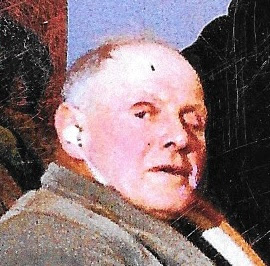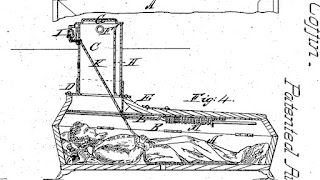Introduction
 |
| Lil Cochrane |
Most people who attended Earlston Primary School in the 1950’s and 1960’s would name Lil Cochrane as a ‘good teacher’.
But Lil was much more that just Primary 6 teacher. She contributed so much more to the community.
Lil, or to give her her formal name, Elizabeth Cochrane, was born in Gordon, Berwickshire, on November 2nd, 1906 to David Cochrane and his wife Elizabeth (nee Thomson). David was a general labourer from Swinton, Berwickshire and Elizabeth was from Canonbie, Dumfriesshire. For a time they had lived in Dumbartonshire where Lil’s elder sisters, Marion and Barbara, were born. Lil’s other elder siblings, James, John, and Christina, and younger brother David were born in Gordon. By 1912, the family had moved to Earlston, living in Thorn Cottages where the youngest family member, Jeanie, was born.
Teaching
Lil attended Berwickshire High School, Duns, taking her Lower and Higher exams (as they were known then) between September 1919 and July 1922.
In October that year she attended Moray House, the teacher training college in Edinburgh. She graduated in June 1924 and took up her first appointment at Reston public school.
She was promoted several times over the years and taught at number of schools, including Gordon primary school. She would continue to hold a strong bond with Gordon through her community work even after she was living and teaching in Earlston.
 |
Lil Cochrane with her class at Gordon Public School 1936 |
Former pupils of Lil during her years in the 1950s and 1960s at Earlston recall her classroom as being a place of quiet calm, a place where learning was entertaining. She encouraged her pupils by working with them on a one-to-one basis to give them additional support where needed, sometimes rewarding work well-done with a few pennies. She encouraged curiosity in her students to look at themselves and their surroundings in often the simplest and funs ways for example drawing caricatures of the children. She instilled confidence by having the pupils take part in the annual musical with pupils from Primary 6 & 7 which she and Mary Rodger (later Mrs Weatherly) co-produced.
Her influence extended beyond her classroom, through her work in the community, which no doubt shaped the children’s personal relationships and contribution to society.
.jpg) |
Lil Cochrane, front row, third right, with Earlston Junior Secondary School staff |
Community involvement
The Cochrane children were encouraged to participate in community events from an early age. When the Gordon Horticultural Society held its fifth annual flower show in 1909, Barbara, Chrissie and Lil Cochrane were all prize winners.
In 1922, when the Cochrane family were living in Earlston a musical evening was organised by the United Free Church of Scotland Women’s Foreign Mission when Chrissie and young David Cochrane participated in the show. Other players included Margaret Robb, Magdalene Rutherford, Nellie Fox, and May Frater.
In years to come Chrissie Cochrane would be elected president of the Earlston branch of the WRI.
For her part, you can judge what Lil considered important and worthy causes by the clubs and societies she participated in. For instance, she was a member of the Personal League of Service, a short lived group that produced garments for the ‘distressed and unemployed’. The group was formed in 1933 and held its last meeting in 1935. During its brief time the group made over a thousand garments for the needy.
Lil was a member of the Scottish Rural Workers Approved Society, an early trade union for rural workers, and, as a delegate, was nominated to attend its annual conference in 1939.
Her involvement with her former pupils would continue through her work with the Girl Guides and the Sunday School.
Her contact with the girls in the village was enhanced by her role in the Earlston Girls’ Club. In 1938, Lil was vice-president of the Club and the number of members and range of activities grew.
The following year, and no doubt influenced by Lil’s love of theatre, the Club staged a play. The Southern Reporter described the event:
‘The members of Earlston Girls’ Club gave an excellent presentation of the play, “Simple Simon.” All the players acquitted themselves in a very creditable manner, and were fully deserving of the warm appreciation of the audience. The cast was as follows: —Jim Strong. Elsie Readman; Lady Proudfoot, Christine Paton; Rose (her daughter), Betty S Kerr; Simple Simon, Elizabeth Cochrane; Mrs Simon. Helen Paxton; Jack and Jill (their children). Chrissie Burrell and Eunice Keillor; Bill Brag (the pieman). Jean Cochrane; Sylvana (Queen of the Fairies), Mary P. Kerr; Captain Bluenose, Bessie S. MacGregor; Pedlar, Madge Graham; Showmen, Jessie Paxton, Dorothy Burrell. Jenny Stafford. The members of the chorus of villagers, sailors, and native girls were; Annie Aitchison, Helen Angus, Ruby Archibald, Dorothy Burrell, Muriel Cowe, Eileen Chisholm, Isa Darling. Winnie Frater, Madge Graham, Betty Gibson. Annie Gillie. Nan Hunter, Nan Hollands, Norma Hollands. Ella Hood, Jean Mack. Ella Montgomery, Martha McLeish, Mary Paterson. Jessie Paxton, Rena Paxton. Mary Rodger. Jenny Stafford, Mary Young. The orchestra members were: Violins —Mrs McCrae, J. Kerr, John Armstrong; trombone — W. Fisher: cornet - A. Hewitt; drums - J. M. McBurnie. Accompanist - Margaret Milton.’
 |
| Girls' Club parade on Coronation Day |
1941 and 1942 were busy years for Lil. In 1941, the Border Union of Girl’s Clubs was formed. Representatives from Earlston, Kelso, Peebles, Hawick, Jedburgh and Innerleithen attended a meeting and the constitution was drawn up. Lil was elected as secretary and the other elected officials were President Lady Stratheden and Campbell; Vice-president Miss Hope of Earlston; and Treasurer Mrs Logie.
Later that year the Berwickshire Education Authority, under its Juvenile Welfare Scheme, held an inaugural meeting to the Earlston Youths’ Club. Unsurprisingly Lil was elected as leader.
At a national level and, influenced by the war in Europe, the government announced the formation of the Girls Training Corps (GTC).
The aim of the GTC was to prepare girls for service to their community and to support the war effort when they reached adulthood. The Corps was open to girls aged between 14 to 20.
Activities included learning to act as bicycle couriers, learning morse code, aircraft recognition, gymnastics, homemaking, craft-work, public affairs, land navigation, learning first aid, marksmanship, firefighting, and assisting with air warden duties.
The GTC was organised into local units lead by an adult commandant.
Unlike their male counterparts in other cadet organisations, members of the GTC had to provide their own uniforms using clothing coupons. The uniform consisted of black shoes, navy blue skirt, white blouse, navy blue tie, GTC badge, and a navy blue forage hat.
In June 1942, a meeting was held at Earlston with a view to forming a Girls' Training Corps. Miss Hope, Cowdenknowes, introduced the Countess of Haddington who explained how the Corps came into existence, and indicated its recognition by the Government. Lil was elected as Area Commandant for the Earlston GTC.
Within 6 weeks, Lil had established a growing membership who enjoyed a series of lectures the following speakers—Mrs Scott Aiton of Legerwood gave a talk personal hygiene; Nurse Dowie on character-building; Mr Hector Brodie, on first aid in-gas attack; Miss Bremner. M.B.E., Earlston. assisted by two Land Army girls, from Georgefield Farm, talked about the Land Army and its national importance, while the girls gave interesting insights as land workers.
In December 1942, the government announced that it would no longer accept clothing coupons for GTC uniform items. Despite this the Earlston GTC continued to grow with regular meetings held in Earlston and Gordon. Activities included drill instruction conducted by Sgt. Major Crosbie of the Home Guard, PE led by Mrs Campbell, wife of the Earlston GP, Aircraft Recognition and learning morse code.
There were, however, lighter moments when, for example, the girls were treated to talk on ‘Beauty Culture’ by an unnamed expert.
Earlston Amateur Dramatic Society
In 1943 a lecture was given in the school hall. The lecturer was Mr Paterson Whyte, organiser of the Scottish Community Dance Association on the topic of drama to encourage amateur dramatic societies. It appears that the seed was sown and within a few years the Earlston Amateur Dramatic Society was formed. In the late 1940s the Society performed a number of plays, not just in Earlston, but entertained audiences in Gordon, Duns and Lauder. In 1950, at a meeting in the Court Room Lil was elected Producer. Other officials elected were President, Mrs A. Brownlie; chairman, Mr F. Weatherby; Hon. secretary Mrs H. Cossar, Summerfield Terrace. Earlston; Hon. treasurer, E. Kerr; executive committee, Miss Blackie and Mr Sanderson.
 |
| Unnamed production from late-1950's l to r: Mrs Robson, Jock Stafford, Heath Brunton, Walter Taylor, Mary Lothian, Ian Buckham, Helen Lang |
 |
| Sailor Beware staged late-1950's Standing l to r: Fred Weatherly, Mrs Buckham, Lil Cochrane Seated l to r: Ian Buckham, Mary Lothian, Walter Taylor, Helen Lang, Mrs Robson, Jock Stafford |
Lil would continue to produce many plays for the Dramatic Society over the coming years, but that did not stop her being involved with other groups. The Girls Training Corps was disbanded and the Girls Club, led by Lil, resurrected, she also participated in the Girls Guides and Sunday School.
In 1951 Lil was elected president of the Earlston Ladies Club. Lil’s sister, Chrissie was elected secretary, Mrs Smith, treasurer, all supported by a committee consisting of Mrs Burns, Mrs Wyllie, Mrs D. Bell, Mrs Readman, Mrs Malcolm, and Mrs R. Thomson.
Lil’s love of theatre was first documented in 1938 when she staged ‘Simple Simon’ with the Girl’s Club. Fourteen years later Lil once again involved the school children in a play. In 1952 the Berwickshire News and General Advertiser reported:
A play entitled "Snow White and the Seven Dwarfs" was presented the pupils of Earlston Junior Secondary School in the School Hall on Thursday and Friday evenings of last week. Miss L Cochrane was the producer, and great credit reflects on her for the very fine performance the cast. Principal parts were played follows —Angela Brunton (Snow White): Ronald Hollands (Prince); Patricia Doyle (Queen): and Pat McInally (Huntsman). The Hall was filled to capacity on both evenings. Mr Jas. Young, headmaster, accorded special vote of thanks to Miss Cochrane, producer: Miss Davidson for the scenery: Mr Malcolm for the erection of the stage: the accompanists. Miss B. S. Kerr and Miss M. L. Milton, and all those who supported the effort of the pupils. Now that the school have their own staging and scenery, it is hoped to have further small plays from time time.
Ten years later and the play was staged again.
 |
| 1962 School production of Snow White & the Seven Dwarfs Lil Cochrane (l) and Mary Rodger (r) being presented with bouquets |
Lil retired from the Earlston school in 1964. She continued to live with her sister Christina, who died in 1984, in a flat they shared overlooking The Square.
Lil moved to Perthshire, where she had family. Then, in 1991, at the Tomdoran Retirement Home, she passed away aged 86.
While researching this blog, I found several reports of prize-giving at a primary school in Coupar-Angus, Perthshire. The Cochrane Prize for art was awarded to children in Primary 6 and &. It's tempting to think that this may have been another legacy from Lil.








